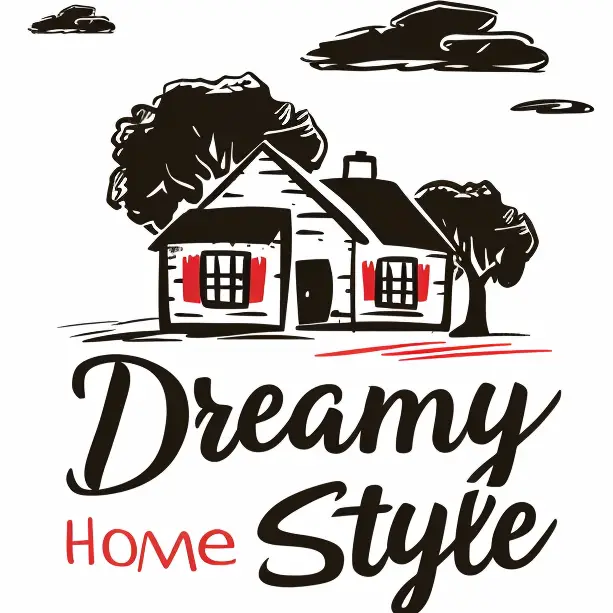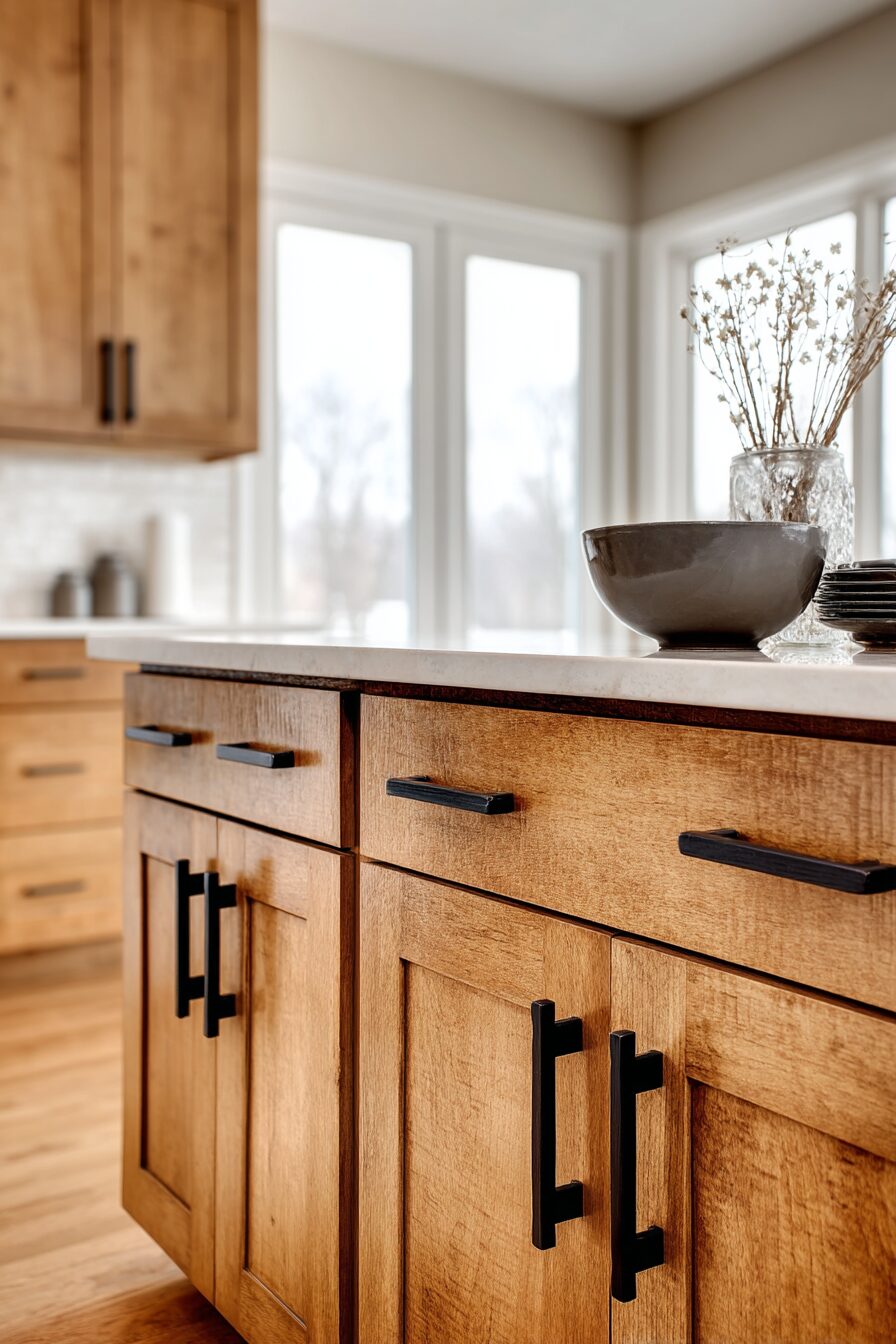Golden oak cabinets are experiencing a major revival in kitchen design, bringing warmth and natural beauty back into modern homes.
These classic cabinets, once considered outdated, are now being reimagined with fresh approaches that highlight their gorgeous grain patterns and honey-toned hues.
If you’re renovating an existing kitchen or planning a completely new space, these stunning golden oak cabinet designs will inspire your next project.
Modern Farmhouse Golden Oak
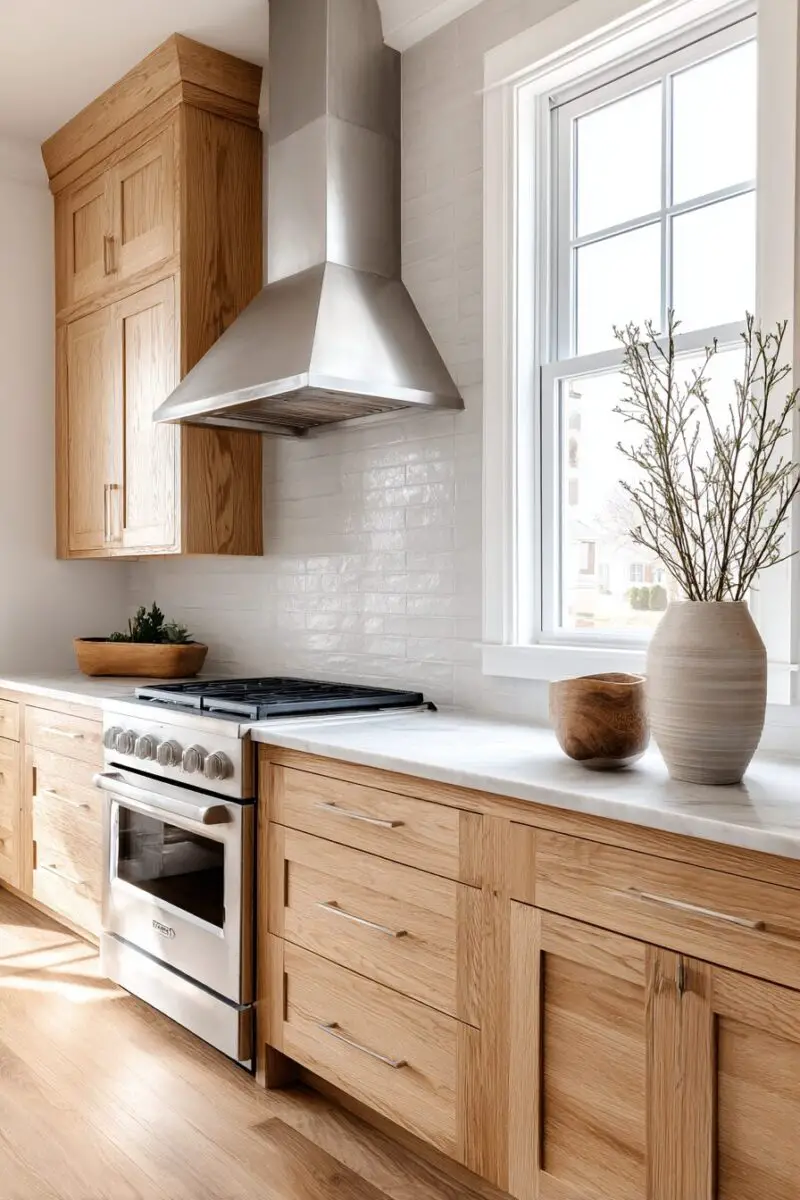
The farmhouse aesthetic gets a contemporary upgrade when paired with the natural warmth of golden oak cabinetry.
This design combines rustic charm with clean modern lines for a look that feels both timeless and on-trend.
By incorporating golden oak cabinets with a slightly distressed finish, you’ll create that lived-in farmhouse appeal without sacrificing sophistication.
Add some open shelving in matching golden oak to display favorite dishes and heirloom pieces.
The contrast of white subway tile backsplash against these warm wood tones creates a stunning visual impact that draws the eye immediately.
For countertops, butcher block or light quartz provides the perfect balance without competing with the beauty of the wood.
Pendant lighting with simple metal shades hanging over an island or dining area enhances the modern farmhouse aesthetic.
Incorporate a farmhouse sink—either in crisp white porcelain or hammered copper—to complete this look with authentic character.
Don’t be afraid to mix in some antique accessories or vintage-inspired appliances to enhance the farmhouse charm while maintaining modern functionality.
The beauty of this style lies in its ability to feel both contemporary and nostalgic simultaneously.
With proper sealing and care, your golden oak cabinets will continue to develop a rich patina over time, adding to their farmhouse appeal.
Madison’s Current Obsessions
Perfect Kitchen Table Colors for Maple Cabinets: 5+ Designer-Approved OptionsContemporary Golden Oak with Contrasting Countertops
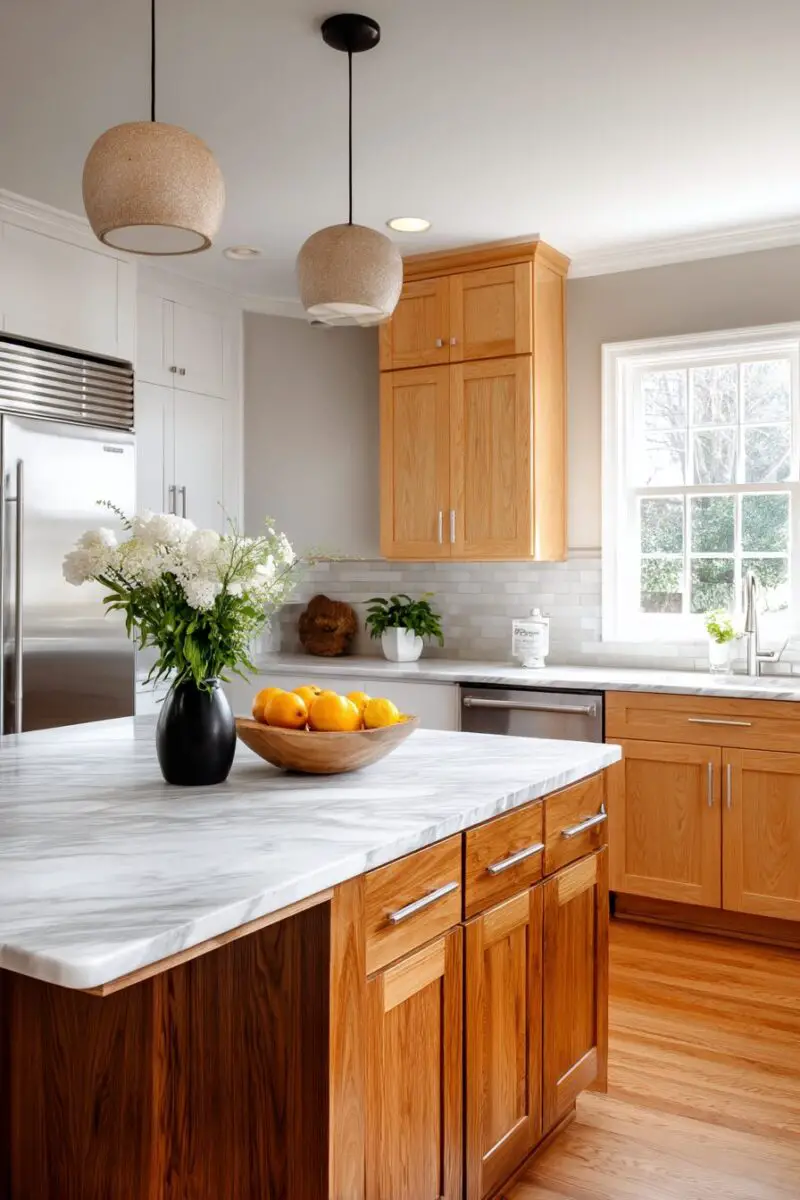
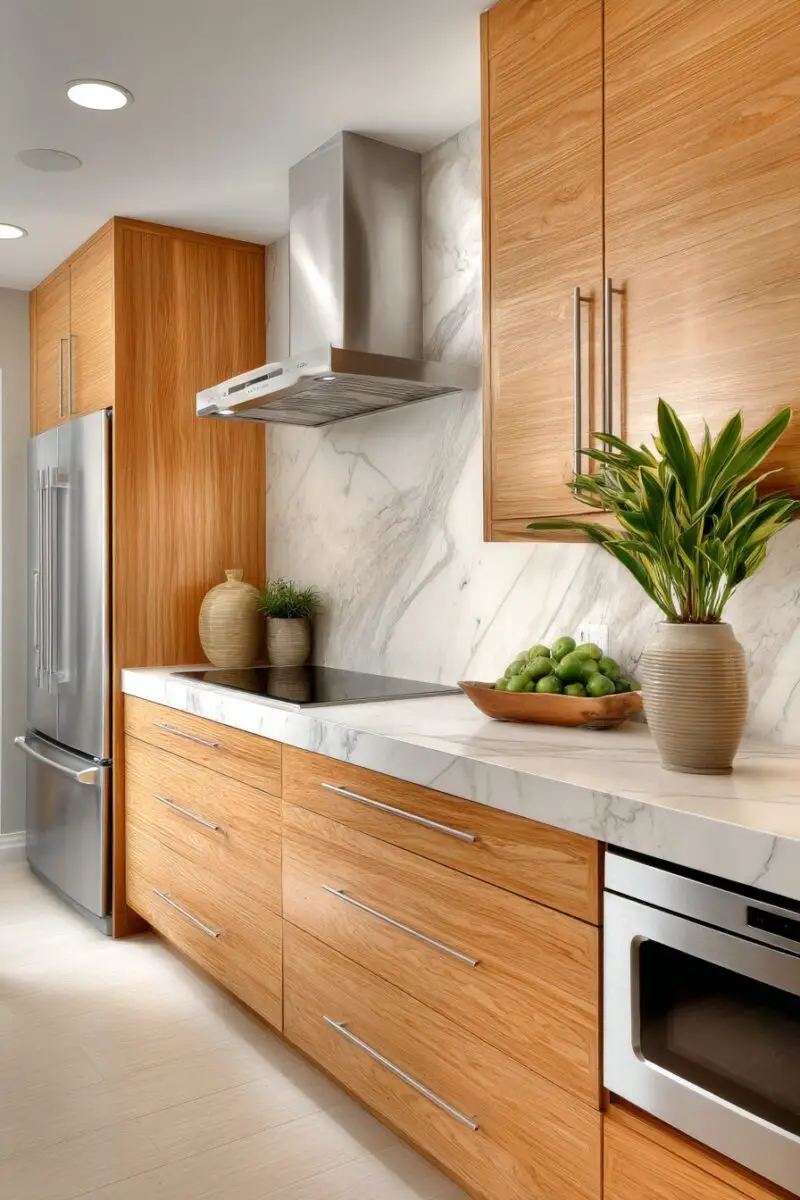
Creating dramatic contrast is the secret to making golden oak feel thoroughly modern and attention-grabbing.
Dark countertops in materials like soapstone, black granite, or even concrete provide striking contrast against the warm golden tones of oak cabinetry.
This high-contrast approach immediately updates the traditional look of golden oak and creates a kitchen that feels intentional and designer-approved.
Sleek, minimal hardware in brushed nickel or black further enhances the contemporary feel without detracting from the natural beauty of the wood.
For backsplash options, consider dark subway tiles, geometric patterns, or even a solid slab that matches your countertops for a seamless look.
Under-cabinet lighting becomes especially important in this design style, as it highlights the beautiful grain patterns in your golden oak cabinets.
Modern appliances with clean lines and minimal detailing help maintain the contemporary aesthetic throughout the space.
The flooring choice can either complement the golden oak (with similar warm tones) or continue the contrast theme with cooler gray or black options.
For an ultra-modern take, consider incorporating some golden oak floating shelves against a dark wall for display space that feels architectural and intentional.
This contemporary approach transforms golden oak from traditional to trend-setting with just a few strategic design choices.
By focusing on dramatic contrasts, you’ll create a kitchen that photographs beautifully and makes a bold statement.
Design Your Dream Room in Minutes! By DreamyHomeStyle
🏡 Start Creating FREE →Madison’s Current Obsessions
10+ Designer-Approved Kitchen Table Colors for Honey Oak Cabinet SpacesTwo-Tone Golden Oak Kitchen Designs
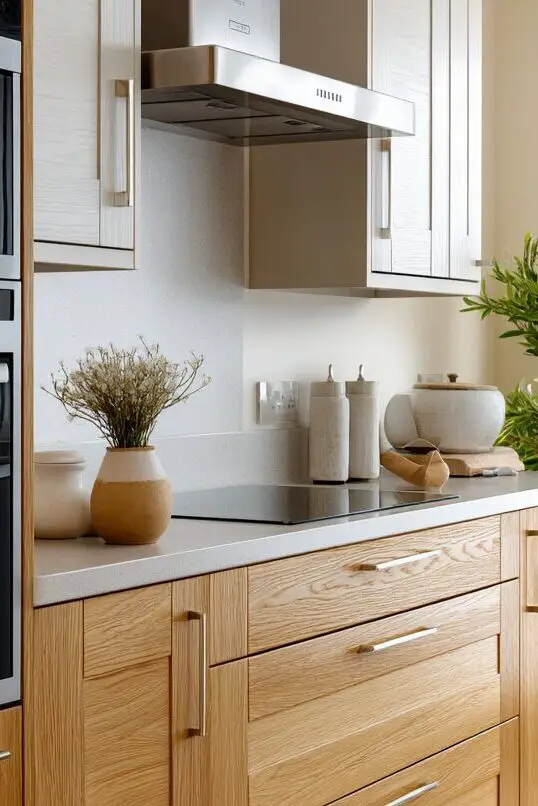
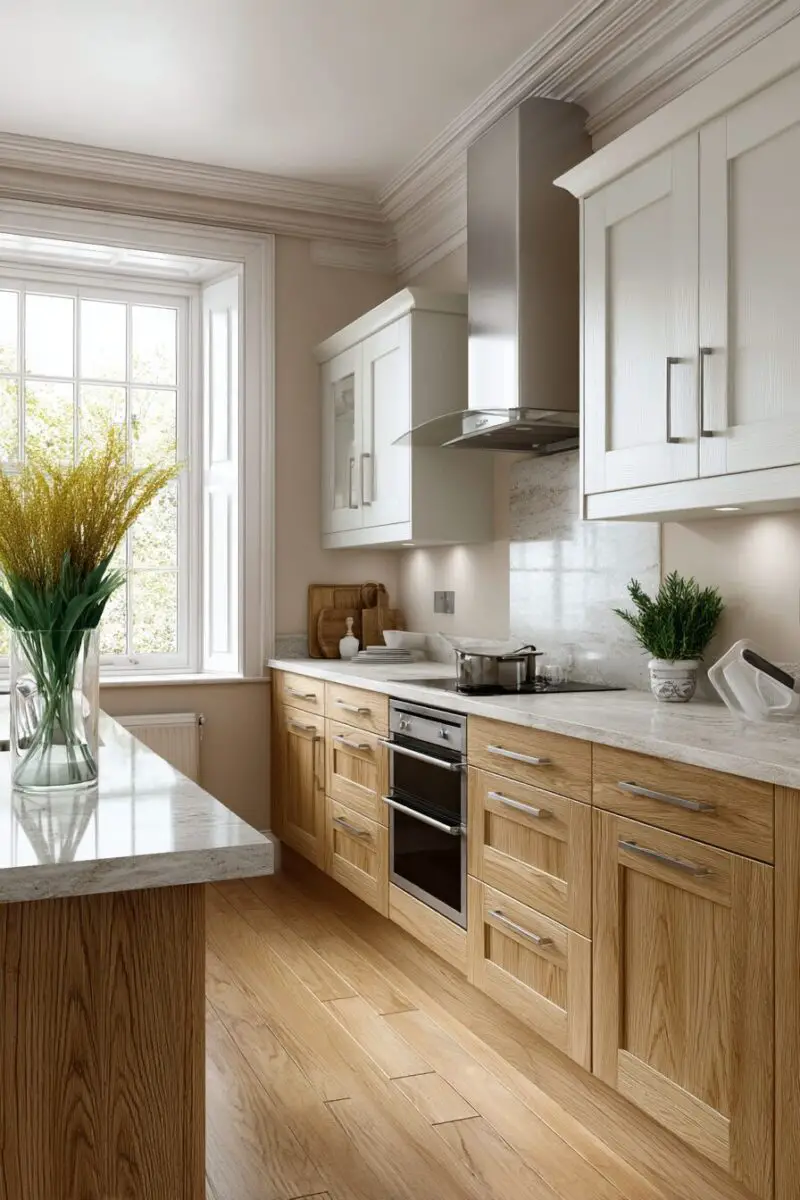
Embracing the two-tone cabinet trend gives your golden oak kitchen a fresh, designer-approved update that feels custom and current.
The key is pairing your golden oak upper or lower cabinets with a complementary color that enhances rather than competes with the wood’s natural beauty.
Alternatively, consider golden oak upper cabinets with crisp white lowers for a lighter, airier feel that still showcases the wood’s warm tones.
The two-tone approach works particularly well in larger kitchens where all-wood cabinets might otherwise overwhelm the space.
For island designs, consider making your island the contrasting element with a painted finish while keeping perimeter cabinets in golden oak.
This strategic approach draws attention to your island as the centerpiece of your kitchen.
When selecting paint colors to pair with golden oak, consider the undertones in your specific cabinets—some golden oak leans more orange, while others have more yellow undertones.
For orange-toned golden oak, blues and greens create beautiful complementary pairings that enhance both colors.
Hardware choices become even more important in two-tone kitchens—consider using the same handles throughout for cohesion, or different styles that share the same finish.
Adding a third element through backsplash tile in a neutral tone helps bridge the two cabinet finishes and creates a cohesive look.
Lighting fixtures in mixed metals can tie together the warm tones of the golden oak with whatever complementary color you’ve chosen for the second cabinet finish.
This modern approach to golden oak cabinetry gives you the warmth of wood while still feeling thoroughly current and customized.
Madison’s Current Obsessions
Must-See Paint Colors That Make Dark Wood Cabinets PopGolden Oak with Glass Front Cabinets
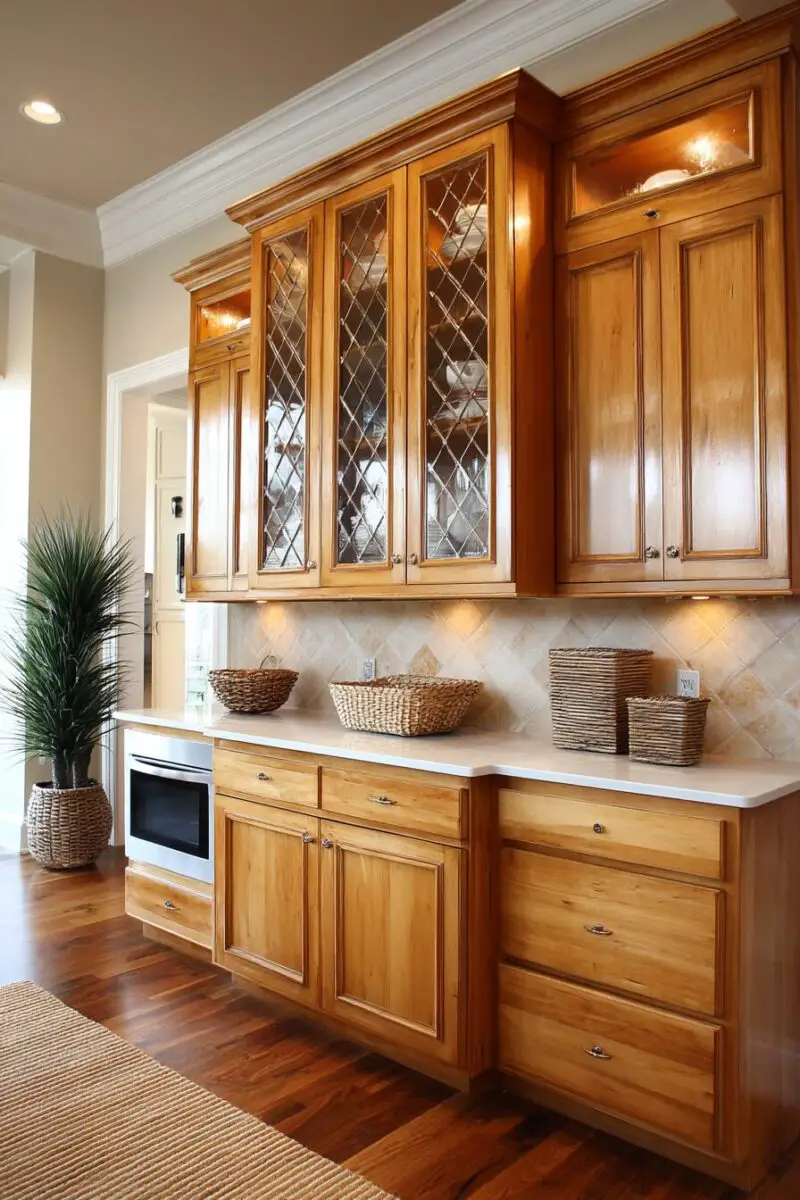
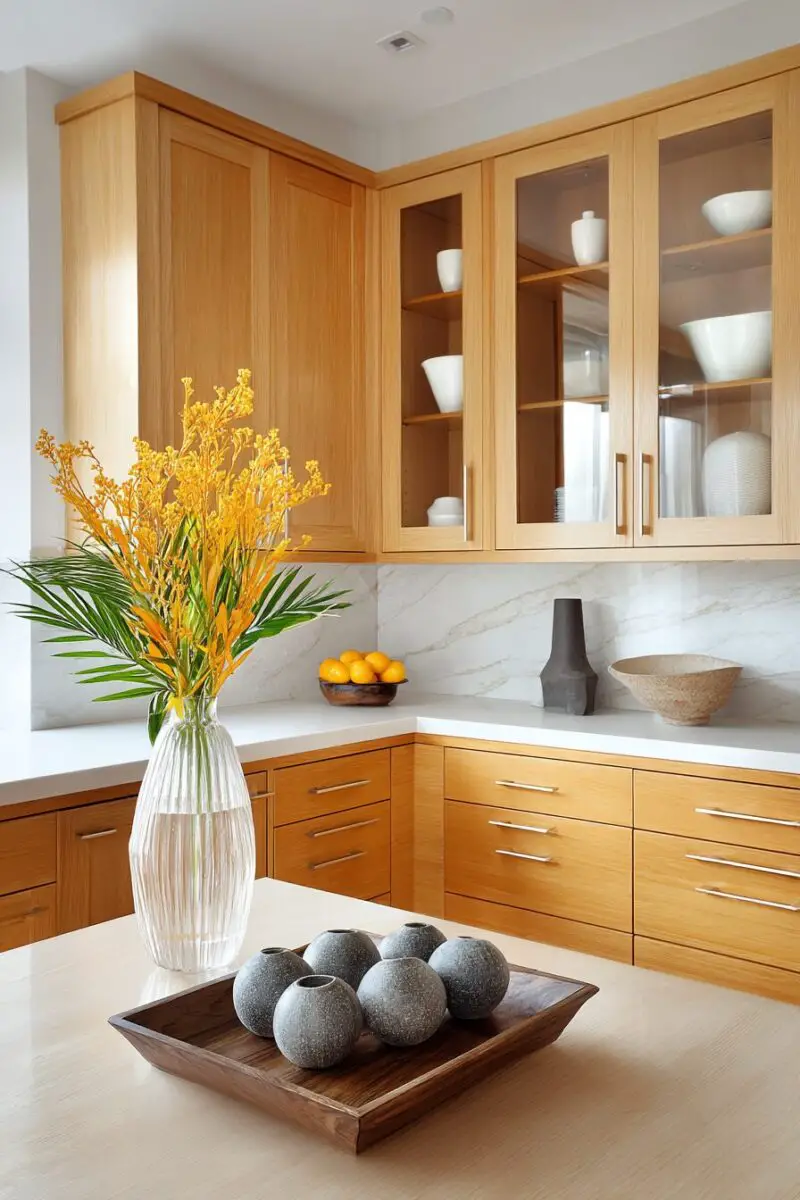
Introducing glass-front cabinets transforms traditional golden oak kitchens into showcases of elegance and light.
The combination of warm wood frames with glass inserts creates an instant focal point that breaks up the solid appearance of all-wood cabinetry.
Strategic placement of just a few glass-front cabinets flanking a window or surrounding a range hood adds architectural interest without overwhelming the space.
Adding interior cabinet lighting behind glass doors creates a warm glow that highlights both the golden oak frames and your displayed items.
This lighting effect is particularly stunning in evening hours, adding depth and ambiance to your kitchen.
Glass-front upper cabinets paired with solid golden oak lower cabinets create a perfect balance of openness and storage practicality.
For a more distinctive look, consider leaded glass, seeded glass, or glass with simple geometric patterns that complement your overall kitchen style.
The contrast of transparent elements against the solid warmth of golden oak creates visual rhythm that keeps your eye moving throughout the space.
When arranging items behind glass doors, use a designer’s approach—group similar items, create color stories, and leave some negative space for a curated look.
White dishes or clear glassware displayed behind glass doors pop beautifully against the golden oak frames.
This thoughtful combination of materials elevates golden oak from merely traditional to elegantly transitional.
Madison’s Current Obsessions
Craft the Perfect Rustic Kitchen: 13 IdeasRustic Golden Oak with Vintage Hardware
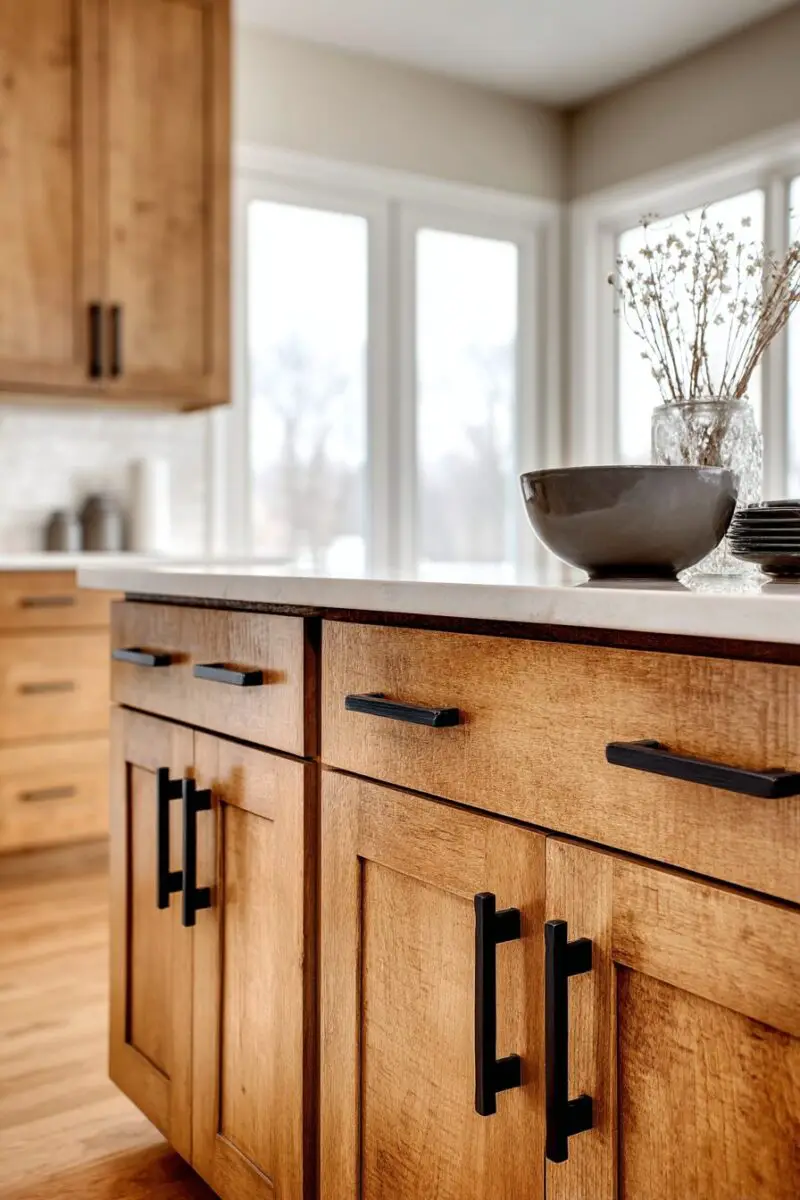
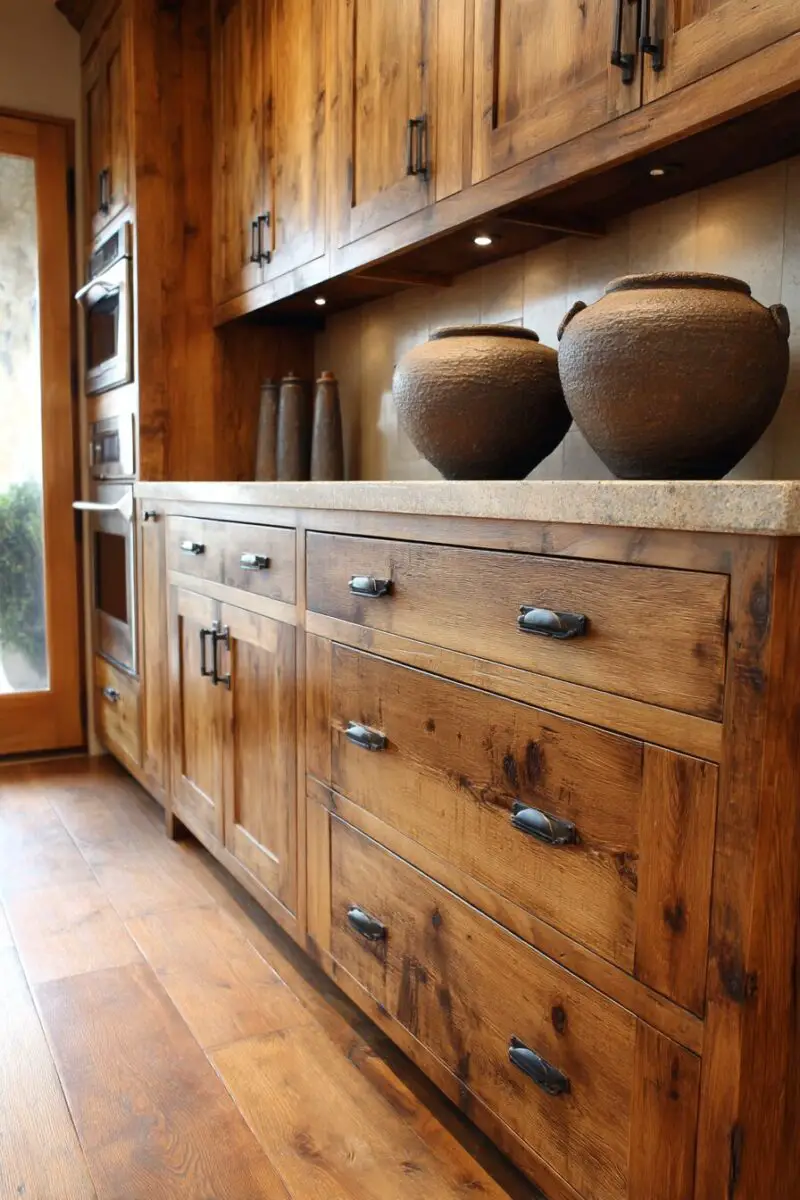
Leaning into the natural rustic quality of golden oak creates a kitchen with authentic character and old-world charm.
The key to this look is embracing rather than hiding the pronounced grain patterns and warm tones that make golden oak so distinctive.
Selecting vintage-inspired hardware in finishes like aged brass, copper, or wrought iron immediately transforms basic golden oak into something with historical character.
Cup pulls, bin pulls, and ornate backplates add detail and interest that elevates the entire cabinet design.
For countertops, materials with natural character like soapstone, honed granite, or butcher block enhance the rustic appeal and develop a patina over time that tells a story.
Incorporating a farmhouse sink—either in crisp white fireclay or hammered copper—anchors the rustic aesthetic and provides a functional focal point.
Open shelving alongside cabinets allows for display of vintage kitchenware and collections that enhance the old-world feel.
Exposed beams, if your ceiling allows, create architectural interest that draws the eye upward and complements the wooden cabinetry below.
Lighting choices significantly impact this style—consider lantern-style pendants, iron chandeliers, or sconces with an antiqued finish.
Flooring in natural materials like wide-plank wood, terracotta tile, or tumbled stone enhances the rustic appeal while grounding the space.
This design approach celebrates the natural beauty and heritage feel of golden oak rather than trying to disguise it.
Madison’s Current Obsessions
10+ Serene Japandi Kitchen Ideas To Transform Your Cooking SpaceGolden Oak with Open Shelving Accents
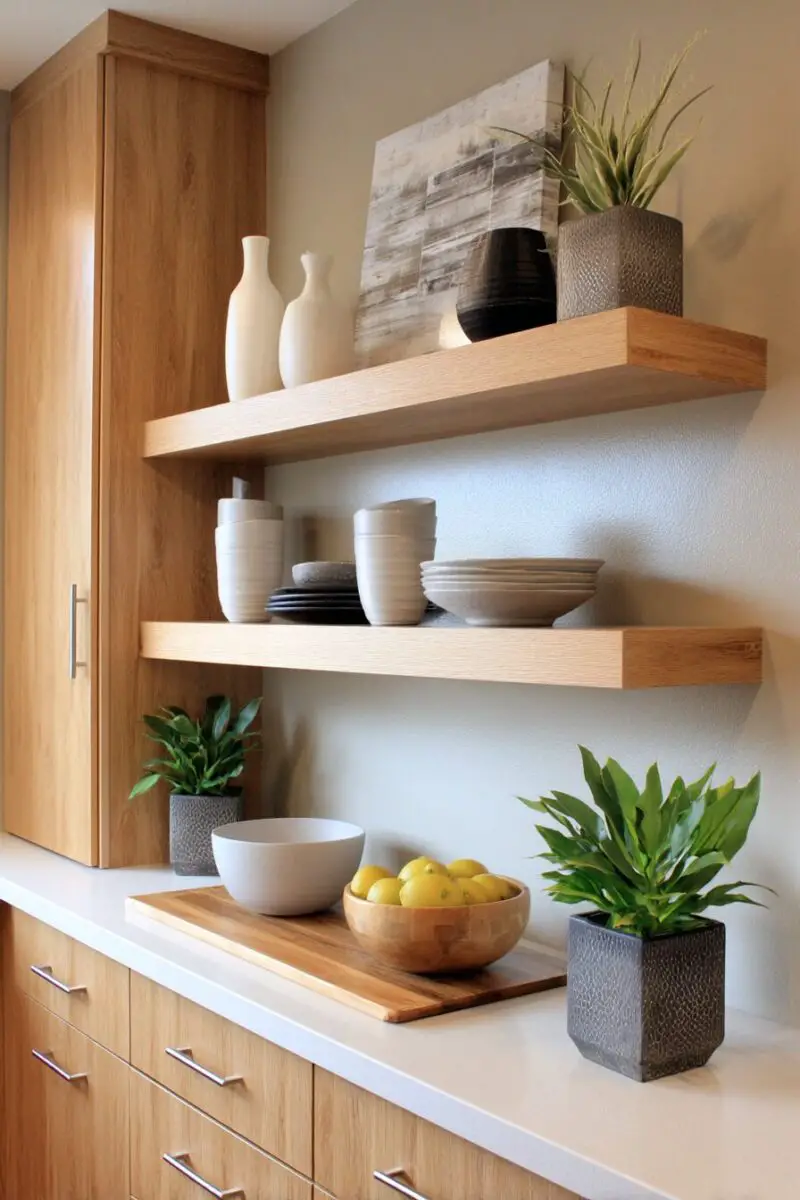
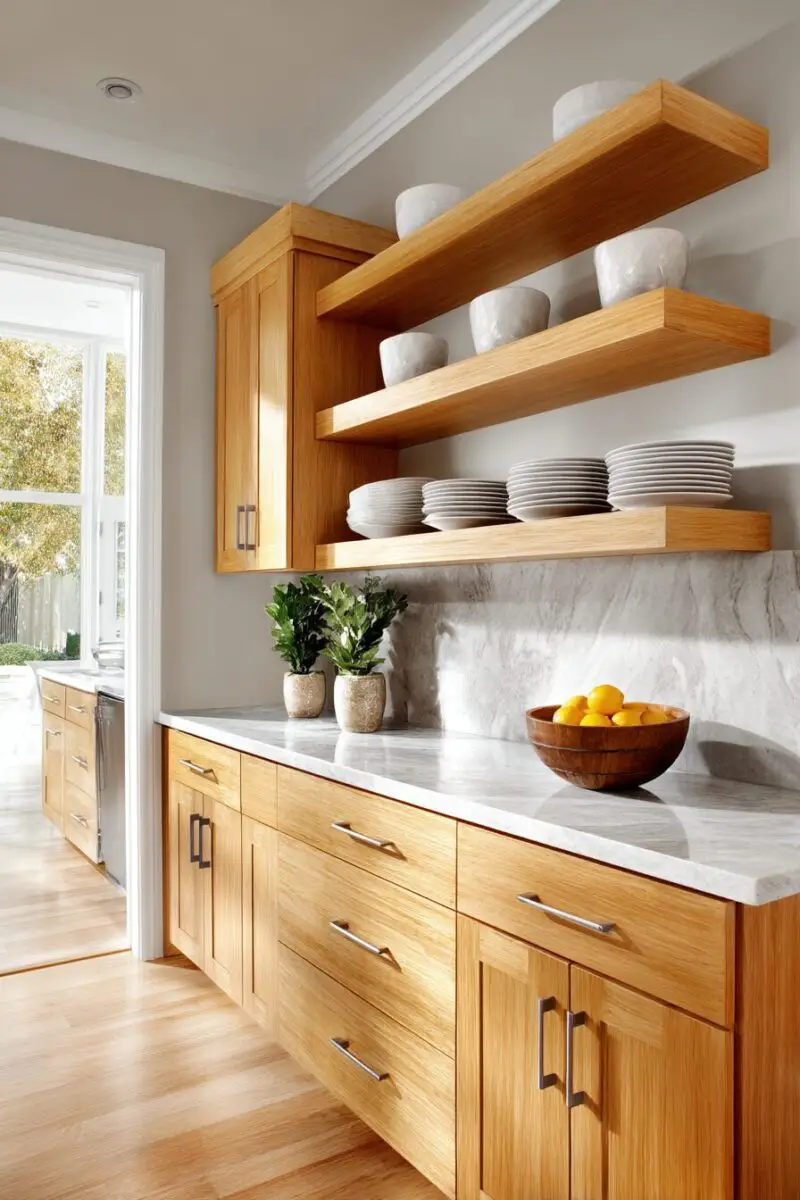
Breaking up walls of golden oak cabinetry with strategic open shelving creates a kitchen that feels both spacious and on-trend.
This approach gives you the best of both worlds—the warmth and storage capacity of traditional cabinetry with the airy, accessible feel of modern open shelving.
The key is leaving enough negative space around displayed items to prevent the shelves from appearing cluttered or busy.
Open shelving flanking a window or surrounding a range hood creates a natural focal point while breaking up the visual weight of full cabinetry.
For a cohesive look, ensure your open shelves are crafted from the same golden oak as your cabinets, with similar edge detailing.
This design approach works particularly well for smaller kitchens, where full upper cabinetry might feel overwhelming or constricting.
Strategic lighting above or below open shelves highlights both the beautiful golden oak material and your displayed items.
When styling open shelves, consider a mix of functional and decorative items—perhaps white dishes that pop against the warm wood tones, plants for a touch of green, and a few decorative vessels.
For a more contemporary take, pair golden oak open shelving with painted lower cabinets in a complementary color.
This partially-open design creates opportunities for seasonal displays and easy updates without a full renovation.
The combination of enclosed storage and open display spaces offers practical functionality while keeping your kitchen feeling current and personalized.
This approach to golden oak cabinetry feels intentional and designed rather than dated or builder-grade.
Madison’s Current Obsessions
Don’t Miss Out On These Beautiful Cherry Cabinet Kitchen Designs!Minimalist Golden Oak Kitchen Designs
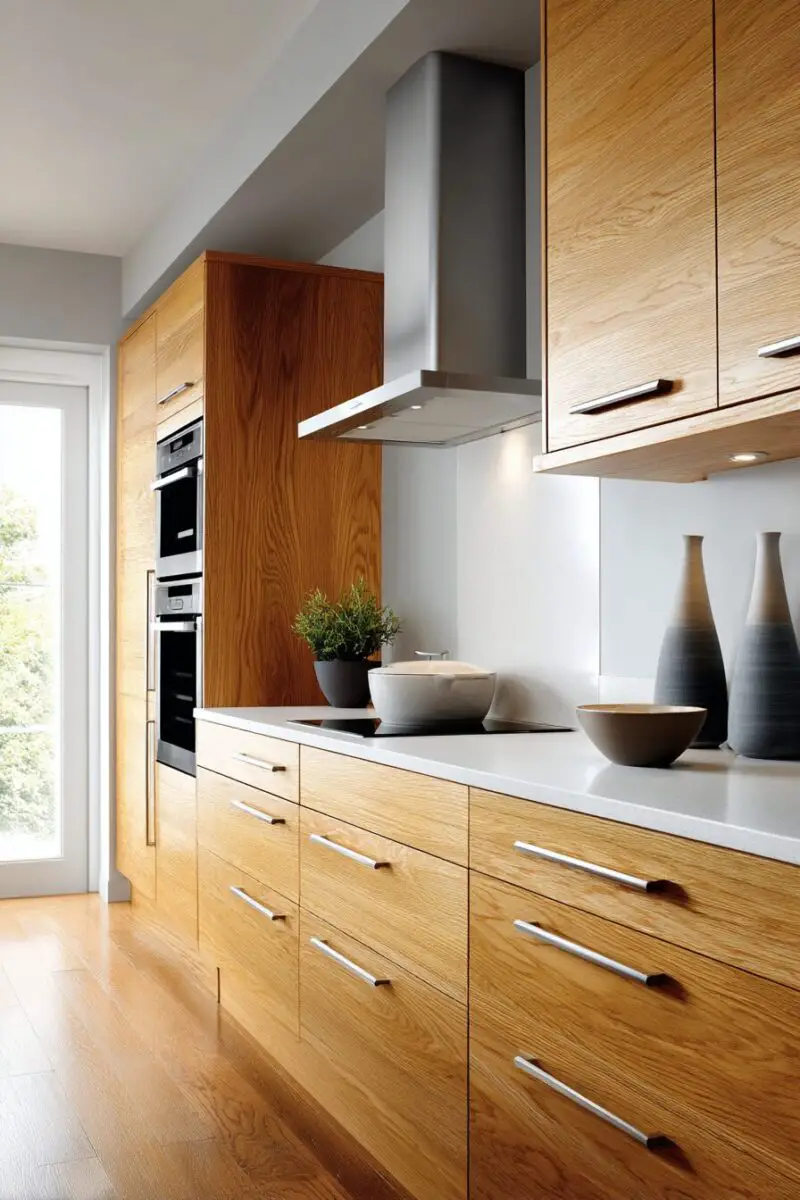
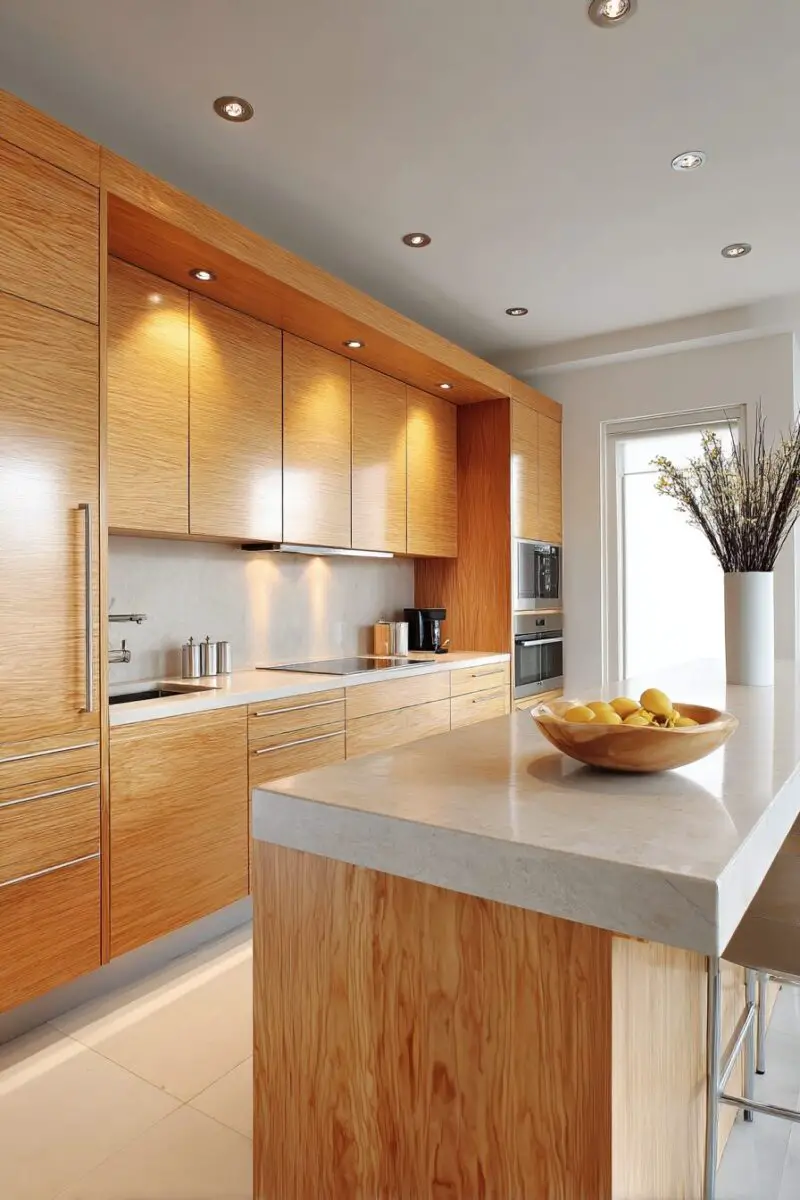
Stripping golden oak designs down to their essential elements creates a surprisingly modern aesthetic that feels clean and intentional.
This approach embraces the beautiful natural material while removing ornate details that might feel dated or overly traditional.
Streamlined cabinet doors without applied moldings or raised panels create a contemporary silhouette while maintaining the warmth of natural wood.
Finger pulls or integrated handles eliminate visual clutter and maintain the minimal aesthetic while adding a custom touch.
For a truly minimal golden oak kitchen, consider full-height cabinets that stretch to the ceiling, creating clean lines and maximizing storage.
Matching golden oak panels for integrated appliances maintain the seamless, uninterrupted appearance that defines minimalist design.
Countertops in simple, monochromatic materials like white quartz or honed concrete provide contrast without competing with the wood’s natural beauty.
A backsplash in the same material as the countertop extends the clean, unbroken lines that define this aesthetic.
Under-cabinet lighting becomes even more important in minimalist design, highlighting the wood grain that provides natural texture and interest.
For flooring, large-format tiles or polished concrete complement the clean lines without competing with the golden oak cabinetry.
This approach proves that golden oak can feel thoroughly modern when paired with the right design elements.
Madison’s Current Obsessions
13 Clever Storage Ideas To Transform Your KitchenGolden Oak with Dark Island Contrast
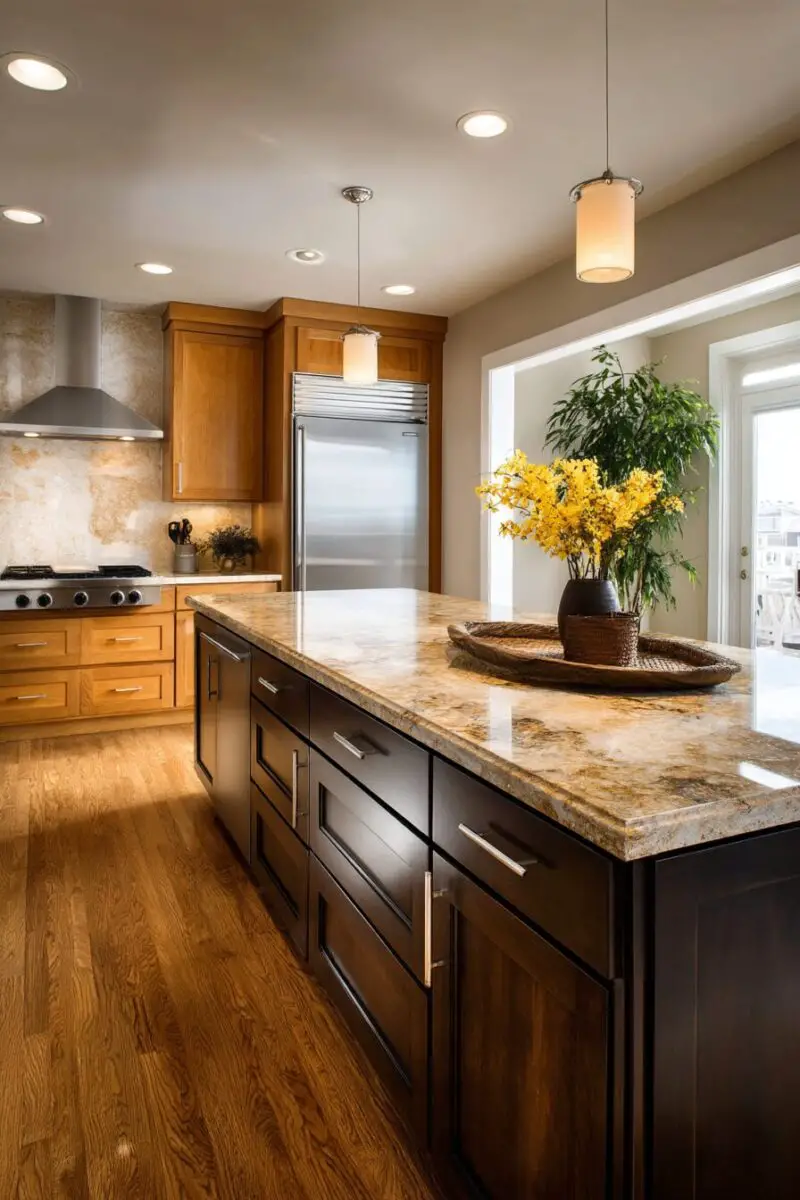
Creating a statement island in a contrasting dark finish instantly modernizes a golden oak kitchen while maintaining its warm appeal.
This approach gives you the best of both worlds—the welcoming warmth of golden oak perimeter cabinets with the dramatic focal point of a dark, anchoring island.
The island becomes the visual centerpiece of your kitchen, drawing the eye and creating intentional design tension.
For cohesion, incorporate elements of golden oak into the island design—perhaps a butcher block section or open shelving in matching wood.
Alternatively, bring elements of the dark island color into small accessories throughout the kitchen for balance and intentionality.
The contrast of light and dark creates visual depth that makes your kitchen feel larger and more designed.
Selecting the right countertop becomes crucial in this design—consider using the same material throughout for cohesion, or complementary materials that enhance both cabinet finishes.
Pendant lighting above the island draws further attention to this focal point while providing necessary task lighting.
Bar stools in materials that reference both finishes—perhaps with golden oak seats and black metal legs—tie the contrasting elements together.
This design approach works particularly well in open-concept spaces where the kitchen is visible from living areas, as it creates architectural interest from all angles.
Hardware choices can either match the dark island for contrast against the golden oak, or bridge both finishes with a neutral metallic tone.
This strategic use of contrast transforms golden oak from a conventional choice to a deliberate design statement.
Madison’s Current Obsessions
13 Smart Kitchen Organization Ideas You NeedTraditional Golden Oak with Crown Molding
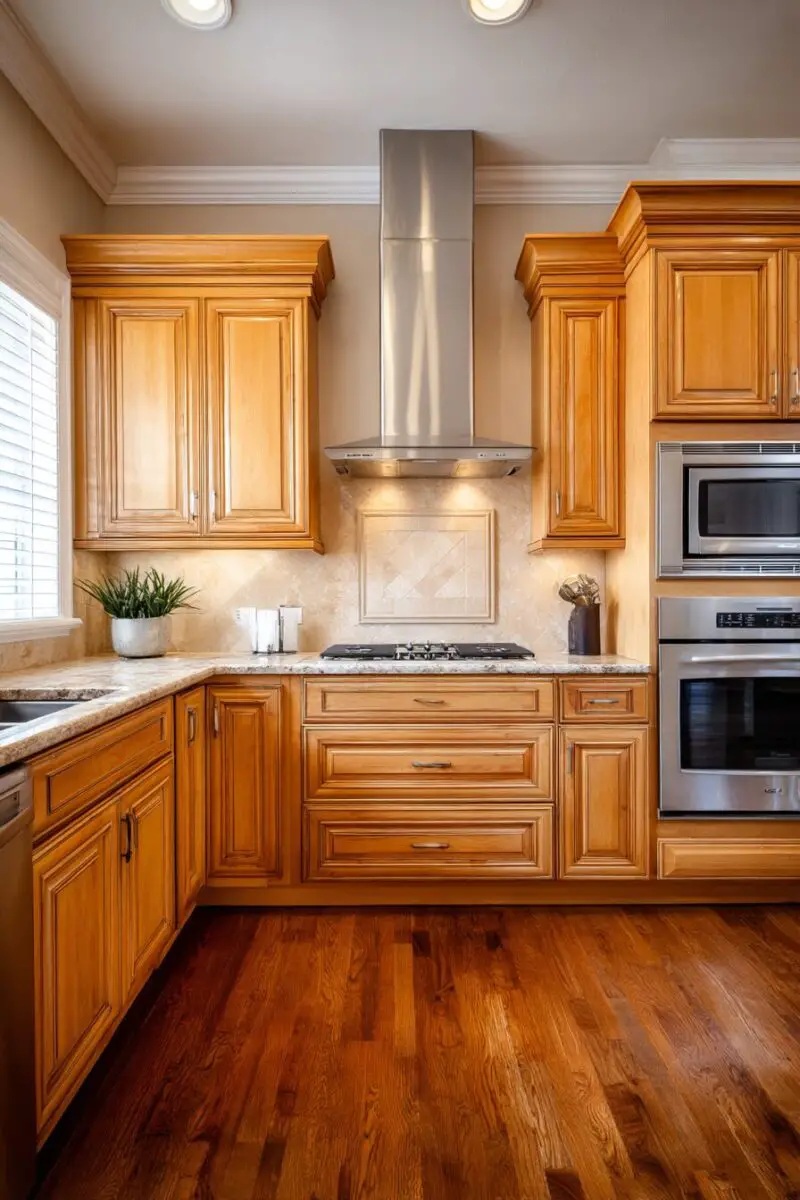
Embracing the traditional character of golden oak with detailed crown molding creates a kitchen with timeless elegance and architectural distinction.
This approach celebrates rather than minimizes the classic appeal of golden oak cabinetry.
Adding substantial crown molding to cabinet tops creates a custom, built-in appearance that suggests craftsmanship and attention to detail.
Cabinet doors with raised panels or applied molding enhance the traditional aesthetic while harmonizing with the crown details above.
This approach works particularly well in homes with traditional architecture or period details elsewhere.
For a truly custom look, extend crown molding around the entire kitchen, connecting cabinet tops to the ceiling for a built-in, architectural effect.
Ornate hardware in finishes like antique brass, bronze, or pewter adds additional detail that complements the traditional styling.
For countertops, edges with detailed profiles like ogee or bullnose enhance the traditional character rather than the straight edges found in more contemporary designs.
A patterned backsplash in natural stone or detailed ceramic tile adds texture and interest that complements rather than competes with the cabinetry details.
Lighting fixtures with traditional elements—perhaps lantern-style pendants or a chandelier over an island—continue the classic aesthetic throughout the space.
This approach creates a kitchen with timeless appeal that will never feel subject to passing trends.
Madison’s Current Obsessions
Transform Your Chaos into Calm: Command Center Kitchen Ideas That Actually WorkOak Kitchen with Modern Backsplash
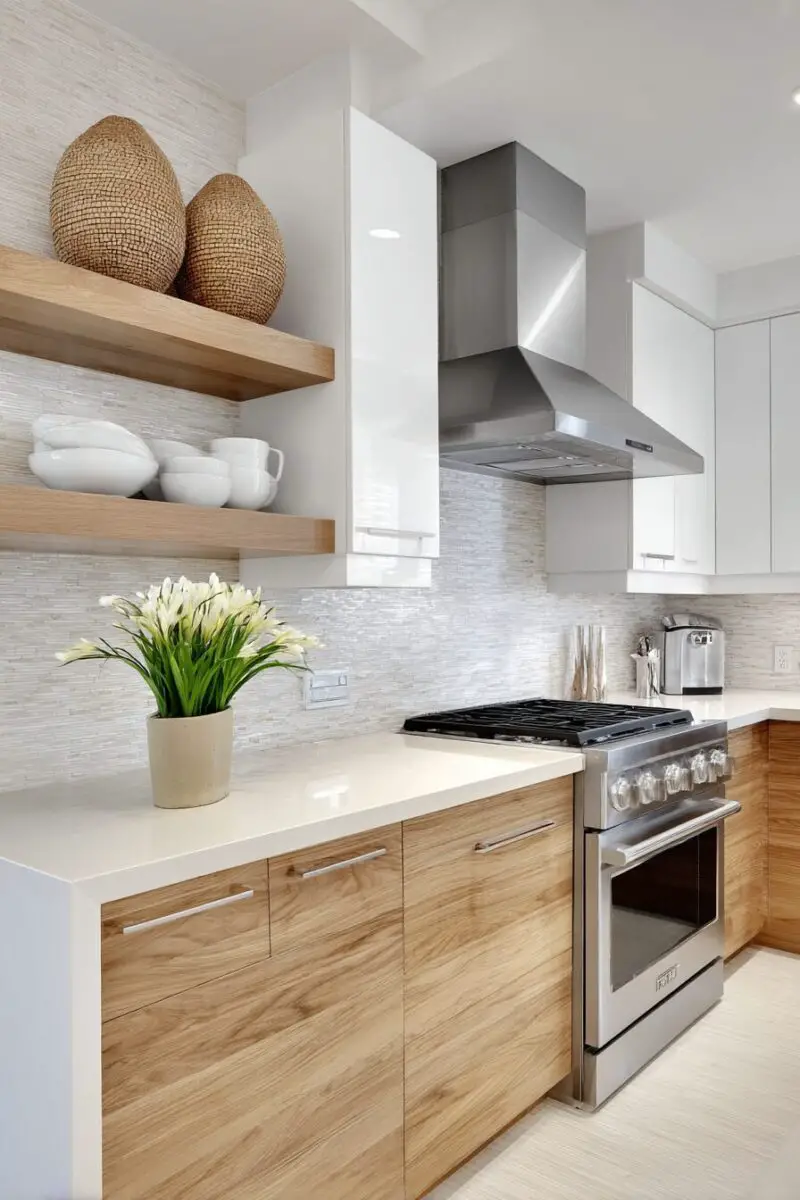
Pairing traditional golden oak cabinetry with a thoroughly modern backsplash creates unexpected tension that feels fresh and intentional.
This high-contrast approach immediately signals that your golden oak cabinets are a deliberate choice rather than a builder-grade leftover.
For dramatic impact, a backsplash in unexpected materials like metal, mirrored glass, or dimensional concrete creates a focal point that transforms the entire kitchen.
The juxtaposition of natural wood against industrial or contemporary materials creates a designed tension that feels current and curated.
Color choices become crucial here—consider cool tones like slate blue, sage green, or even black for maximum contrast against the warm golden tones.
For a subtler approach, white tiles in modern shapes or patterns provide a clean backdrop that allows the golden oak to shine.
Carrying the backsplash material all the way to the ceiling behind open shelving or in cooking areas creates a feature wall effect that anchors the design.
Contemporary pendant lighting that references the backsplash material or color further enhances the modern aspects of your design.
This design strategy works equally well in brand new kitchens or as an update to existing golden oak cabinetry that you’re not ready to replace.
The contrast of time periods—traditional cabinetry with contemporary backsplash—creates a kitchen that feels collected over time rather than purchased as a matching set.
This approach proves that golden oak doesn’t have to be replaced to create a kitchen that feels fresh and current.
Golden oak cabinets offer timeless warmth and character that many modern materials simply can’t match.
With these design approaches, you can embrace the natural beauty of golden oak while creating a kitchen that feels intentional, current, and uniquely yours.
The rich, honey tones and distinctive grain patterns provide a warmth and depth that manufactured materials often lack.
